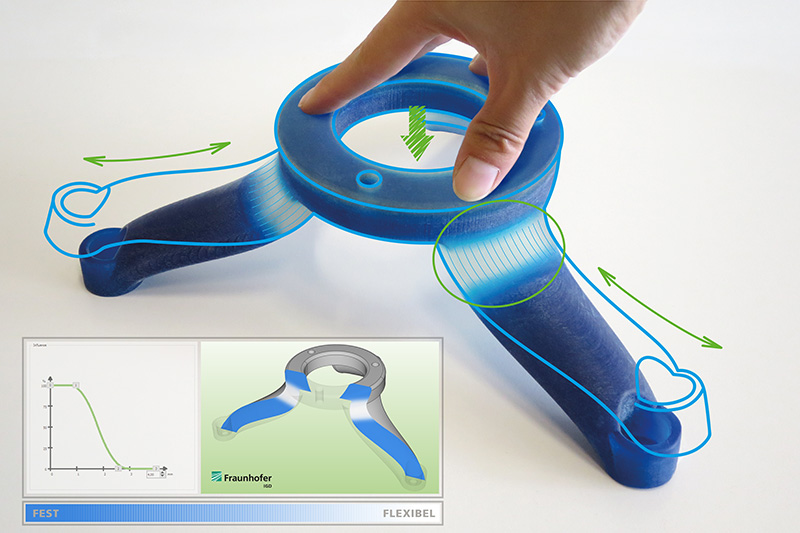Graded components: interactive and immediate definition
Functionally graded materials allow components to be optimized to meet requirements. This is why researchers at Fraunhofer IGD are using the application GraMMaCAD to elegantly and intuitively define material distributions in CAD models. Together with multi-material 3D printing, there now exist new possibilities for meeting more complex component requirements.

Compared to traditional manufacturing techniques, additive manufacturing allows for more design freedom. Novel shapes can be created, functions integrated into forms, and different materials combined -- all in a single printing process. Using multiple materials and combining them into multi-materials in particular is becoming increasingly important to industry. Additive manufacturing has ushered in the rise of functionally graded materials, or materials whose properties gradually change along one or even more spatial directions, or according to the geometry/loads of the component. This change is achieved by modifying the material composition or process parameters during the additive manufacturing process, allowing the material properties within a component to be tailored as needed. One example of this would be a gradual progression from firm to flexible material in a damping element, making the transition less prone to failure when the material abruptly changes -- as in our example of a support foot shown below.
With the GraMMaCAD (Graded Multi-Material CAD) software, the Fraunhofer Institute for Computer Graphics Research IGD is providing industry with a tool for their CAD geometries that can help interactively define material distributions and progressions when developing virtual products.
Until now, defining locally varying properties on CAD models has been a laborious and time-consuming process for designers, engineers, and 3D printing service providers. There has been no elegant solution for interactively and intuitively defining locally varying properties. The conventional practice has been either to divide the model into subodels to which various materials are then assigned -- which typically only permits discrete material transitions -- or to assign materials using images (textures) in a preparatory step for 3D printing, with the gradation being produced by varying the texture information; geometric changes required taking special precautions or making manual adjustments.
This gave rise to the question: How can locally varying material information be generated within a three-dimensional component with little effort?
This is where GraMMaCAD comes in. This software is designed to interactively generate volumetric material distributions and gradients with the elegant and user-friendly layout of an interactive image editor. It starts with a CAD model generated by a CAD tool. Fraunhofer IGD’s solution supports a number of popular CAD formats, such as STEP, CATIA, JT, Pro/E, and SolidWorks. Users can choose in GraMMaCAD from three approaches for generating the material distributions in the CAD model. The first approach allows one or more CAD surfaces of the model to be selected. The second approach forms what are called auxiliary geometries, and allows the user to select, e.g., one or more new planes. The first two options generate a graded material progression starting from the selected surfaces that can be interactively modified by the user. The third approach is when the user assigns material information to parts of the CAD model and has the material properties between them automatically computed (interpolated). In this case, the user needs to first break the CAD model down into subcomponents with CAD software and then either assign a specific material to each subcomponent or declare the subcomponent graded. GraMMaCAD then automatically generates the material progression using the environment information.
3D printers that can process multiple different materials in a tight space, such as the series J7 and J8 from Stratasys, can make graded CAD models a reality in principle. However, more and more multi-material 3D printers are entering the market and implementing functionally graded objects for sophisticated designs, such as the Mimaki 3DUJ-553, the Arburg Freeformer, and the Druckkopf Aerosint Selective Powder Deposition Recoater.
 Fraunhofer Institute for Computer Graphics Research IGD
Fraunhofer Institute for Computer Graphics Research IGD